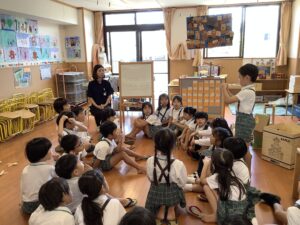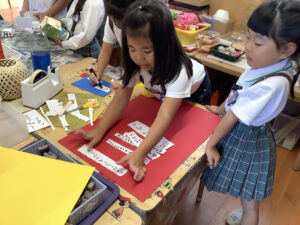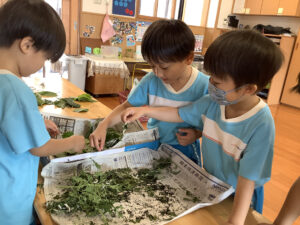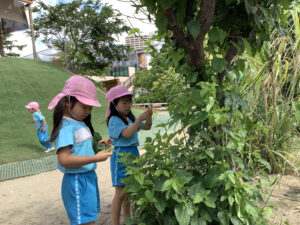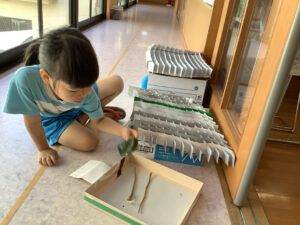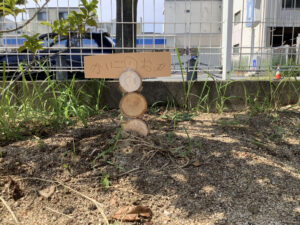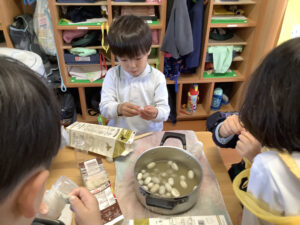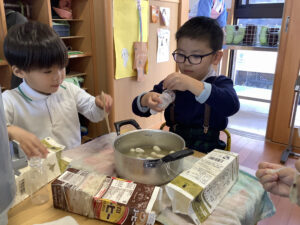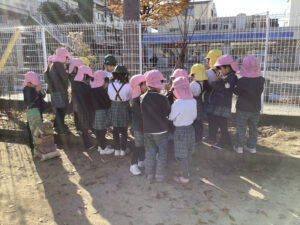-
Nanatsumatsu Youchien (Integrated Centers for Early Childhood Education and Care)
- Level/s of EducationKindergartens, Certified Centers for Early Childhood Education and CareRegionKinki
- Main areas of activityPeace, Global Citizenship Education (GCED)

| Location | 2-27-20,Nanamatsucho, Amagasakishi, Hyogo, Japan |
|---|---|
| TEL. | (+81)6-6418-6732 |
| Website | http://nanatsumatsu.com/ |
| Membership | 2025 |
2024 Annual Report
Biodiversity, Disaster reduction/prevention, Environment, Cultural diversity, International understanding, Peace, Human rights, Welfare, Sustainable production and consumption, Health, Dietary education
Based on the basic corporate philosophy of “Spreading ‘harmony’ with gratitude for encounters and smiling,” the goal is to cultivate the ability to value people, things, and things through the following four areas that the park focuses on, through the efforts of the “TEAM EXPO2025” co-creation challenge at the Osaka-Kansai Expo through the UNESCO School SDGs Assist Project.
He also participates in the Osaka-Kansai ASPnet to exchange information.
In addition, last year’s initiatives at the kindergarten were presented as posters at the 15th Society for the Practice of Early Childhood Education and the 6th Hyogo Youth Eco Forum, and the Hyogo SDGs School Awards 2024 received the Excellence Award, and were selected as one of the Ministry of the Environment’s “100 Best Videos for Environmental Education and ESD Practice in Reiwa 6”. These contents are posted on the website and information is disseminated.
・Hyogo SDGs School Award 2024
・Ministry of the Environment “100 Selected Environmental Education and ESD Practical Videos for Reiwa 6”
http://eco.env.go.jp/jissendoga/kokai/
(1) International Day of Intercultural Learning and Cultural Diversity
As part of the International Day, we worked on World Environment Day, International Day for Disaster Risk Reduction, and International Day of Tolerance. The children thought about what they could do with each anniversary, exchanged opinions, and interacted with other grades, which led to an opportunity to become aware of world peace and human rights.
・World Environment Day
Childcare providers conveyed to the children what kind of earth-friendly initiatives they are through plays, and provided opportunities for the children to think about it with each other.
・International Day for Disaster Reduction
Five-year-old children discussed disaster prevention with their classmates and made International Day Disaster Prevention Day posters and posted them in the park so that other classes and parents could learn about them. We discussed self-confidence, why natural disasters such as fires occur, and what to do when natural disasters do not occur.
・International Day of Tolerance
Holding hands with childcare workers and friends, they became familiar with the world’s dances and music through folk dance, and it was an opportunity to accept the culture of other countries.
Details of the 15th UNESCO School SDGs Assist Project
(2) [Food education activities]
In May, I decided to grow edamame and planted edamame seedlings. At first, the children observed the growth of edamame under the guidance of the childcare staff, but gradually they began to take an interest in the growth of edamame, and they began to be seen willingly watering and observing it. In addition, the children wanted to make a record of their observations of edamame, so they took pictures and wrote them on a certain day of the week every week. In the process, the children noticed that the leaves were torn. When we discussed the cause, we found out that the chickens kept at the kindergarten were eating the leaves. So, when we had further discussions, we came up with the opinion that “if there was a net, we wouldn’t eat it,” so we decided to put a net on it. With the addition of netting, the leaves could not be eaten, and they grew steadily. After that, a lot of edamame was harvested, and we were able to harvest it with great enthusiasm. The harvested edamame was boiled in salt and eaten, but even the children, who are usually not good at vegetables, were willing to eat it because they grew it themselves, saying, “It’s delicious!” In addition, we received sweet potato seedlings from Amagasaki from the Amagasaki City Agricultural Policy Division, grew them in the fields of the park, and harvested them. The children said, “I want to eat it as sweet potato chips,” so I made it into sweet potato chips and ate it.
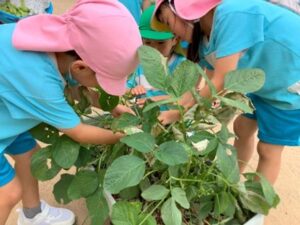
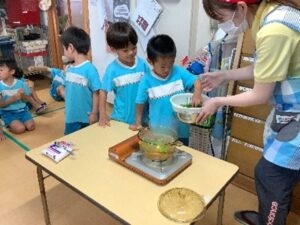
(3) 【Encounter with silkworms】
May. Silkworms were born from eggs and breeding began. Since they had seen the older children raising silkworms last year, they had expressed their desire to raise silkworms from the beginning of their advancement, and they were happy when the silkworm eggs arrived. From that day on, every morning when I went to the park, I could see that they were interested in the silkworms. At first, the nursery staff prepared mulberry leaves for the silkworms to eat, but the children began to go and take care of the mulberry leaves on their own. As the silkworm grows and grows little by little, it begins to talk to the silkworm, touch it, and pet it.
【Silkworm Hospital】
In the course of caring for them, when they found silkworms that were sick, or that were smaller than other silkworms because they could not eat their leaves well, they made “kaiko byouin” and the children began to take care of them separately at the silkworm hospital.
One morning, while changing new mulberry leaves and caring for them as usual, she notices that the sick silkworm is dead. The children put tissues in small cups and placed dead silkworms in them. On that day, all the children in the class went to the kindergarten and buried them in the flower beds in the garden to make a grave. From that day on, the children began to go to the silkworm’s grave on a regular basis.
【Making silkworm cocoons】
As the children continue to care for the silkworms, they begin to notice changes. “Oh, I’ve got silk, it’s time to make a cocoon,” I was having a conversation with my friends. The children had been exposed to silkworms since they were 3 years old, and had looked up silkworms in silkworm encyclopedias, so they had a good understanding of silkworms and did not seem to be panicked by the changes in silkworms.
When the silkworm begins to produce cocoons, it will not touch it, but will watch it. Even younger children were seen gently instructing them, “Once the thread starts to come off, don’t touch it anymore.”
All silkworms made cocoons, and after a while, silkworm moths were born from the cocoons. The children rejoice that the silkworm has become a moth, and look forward to the day when a new silkworm will be born from the eggs produced by the silkworm moth.
【Making a futon with silkworm cocoons】
When it was getting colder, I received a wooden doll in June as part of the Amagasaki City Environment Department’s tree education project. The children love the wooden doll “Molly”. There was an opinion that there was a Molly futon. Children who knew from the silkworm picture book that threads can be made from cocoons should make a futon for Molly out of silkworm cocoons! I made a futon out of silkworm cocoons.
When the children noticed that towels were also colored while playing with colored water, they wondered if they could dye silkworm cocoons as well. Therefore, they dyed the silkworm cocoon with colored water.
【Visiting the Silkworm’s Grave】
When he was making a futon using a silkworm cocoon, a dead pupa silkworm came out of the cocoon, and when he learned that it was a pupated silkworm and was already dead, he said that he would bury it in the silkworm’s grave with him, and he buried it in the silkworm’s grave. From that day on, every day when the pupa comes out of the cocoon, I go to bury it and put my hands on the grave.
(4) [Development of activities to give back to local people]
As local residents went to receive bamboo for Tanabata decorations and gave acorns, the children were often seen writing letters of gratitude and expressing their gratitude. In the course of the food education activities, there was a voice of a child who said, “Why don’t we give back to the local people by sharing the amount with them?” However, there were concerns about food hygiene, so it was difficult to tackle this time. We would like to continue to take on this challenge as an issue for the next fiscal year.

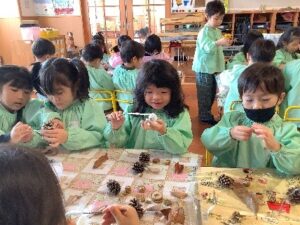
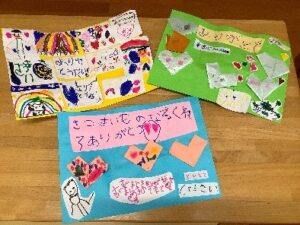
Annual Work Plan
・Next fiscal year’s plan
I would like to deepen this year’s activities and connect them to the next year.
Knowing the preciousness of life
・ In the process of raising silkworms, spinning yarn from cocoons, and developing into manufacturing by connecting with the planting experience, you will learn that various things are made with the life of silkworms and plants, and you will learn the importance of handling things with care.
Partnerships with Local Communities
・The children themselves learn that they are supported by interacting with the local people, and try to convey their gratitude with a sense of gratitude. Children realize that the people of the community are close to them.
No related reports available in English.

